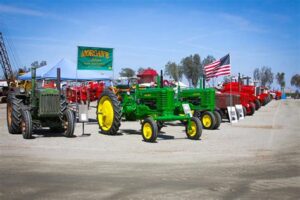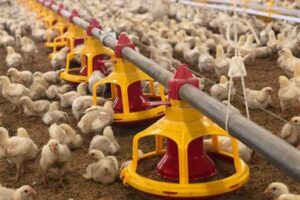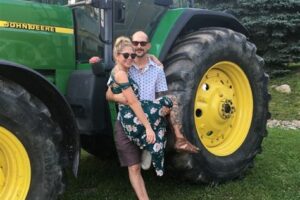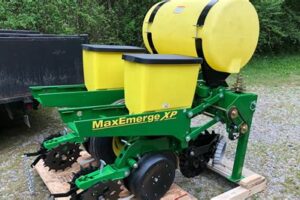Table of Contents
Fish farming equipment plays a crucial role in the aquaculture industry, providing essential tools and technology for efficient fish production. From fish tanks and filters to feeding systems and aeration devices, this equipment ensures optimal conditions for fish growth and health. Discover a wide range of high-quality fish farming equipment designed to maximize productivity and sustainability in the aquaculture sector.
Fish farming equipment has revolutionized the way we produce and consume seafood. With the increasing demand for fish and the decline in wild fish populations, fish farming has become a crucial solution to ensure sustainable aquaculture. From state-of-the-art tanks to automated feeding systems, the advancements in fish farming equipment have enabled farmers to optimize production, improve fish health, and minimize environmental impact. In this article, we will explore the latest innovations in fish farming equipment, shedding light on how these technological marvels have transformed the aquaculture industry.
Fish Farming Equipment: Revolutionizing Aquaculture
As the demand for seafood continues to rise, traditional fishing methods are facing challenges in meeting this growing global need. To overcome these obstacles, fish farming has become a popular and sustainable alternative. Fish farming, also known as aquaculture, involves breeding and rearing fish in controlled environments such as tanks, ponds, or ocean enclosures. This practice requires specialized equipment to ensure the well-being and productivity of the farmed fish. In this article, we will explore some of the essential fish farming equipment that has revolutionized the aquaculture industry.
Aeration Systems
Adequate oxygen levels are crucial for the survival and growth of fish in aquaculture systems. Aeration systems play a vital role in maintaining optimal oxygen levels by introducing air into the water. These systems can vary from simple air stones to more advanced technologies such as paddlewheels, blowers, and diffusers. Aeration systems ensure that fish have access to sufficient oxygen, leading to healthier and more productive fish populations.
Water Filtration and Treatment
Clean and quality water is essential for the well-being of fish. Water filtration and treatment systems remove impurities, toxins, and excess nutrients from the aquatic environment. These systems can include mechanical filters, biofilters, UV sterilizers, and chemical treatments. By maintaining pristine water conditions, these equipment help prevent diseases, improve fish growth rates, and enhance overall fish health.
Feeding Systems
Efficient feeding is crucial for the growth and development of farmed fish. Feeding systems have evolved to ensure precise and automatic delivery of feed to the fish. Depending on the scale of the operation, these systems can range from simple hand-feeding to more sophisticated automated feeders. These systems not only optimize feed utilization but also reduce labor costs, minimize overfeeding, and improve overall feeding efficiency.
Fish Grading and Sorting
In larger aquaculture facilities, fish grading and sorting equipment are essential for managing fish populations effectively. These systems rely on various mechanisms such as size, weight, and appearance to separate fish into different categories. Grading and sorting equipment play a significant role in maintaining uniformity within fish stocks, ensuring proper feeding regimes, and facilitating appropriate harvesting schedules.
Monitoring and Control Systems
Monitoring and control systems enable fish farmers to closely observe and regulate environmental parameters within their aquaculture systems. These systems may include sensors, data loggers, and computerized control panels. By continuously monitoring water quality, temperature, dissolved oxygen levels, and other crucial factors, fish farmers can make informed decisions to optimize fish growth and mitigate potential risks.
Netting and Cage Systems
For fish farms located in open water bodies such as lakes or oceans, netting and cage systems are vital components. These structures provide a confined space for fish while allowing water to flow freely. Netting and cage systems are designed to withstand environmental forces, prevent escapes, and protect fish from predators. Furthermore, they facilitate the convenient monitoring, sampling, and harvesting of fish populations.
Water Pumps and Circulation Systems
Water pumps and circulation systems ensure the proper movement and distribution of water within aquaculture facilities. These systems maintain consistent water flow, which helps evenly distribute oxygen, nutrients, and temperature throughout the system. By preventing stagnant water and maintaining optimal conditions, water pumps and circulation systems contribute to the overall health and vitality of farmed fish.
Harvesting and Processing Equipment
When it comes time for harvest, specialized equipment is necessary to efficiently and humanely catch and process the fish. Equipment such as nets, fish pumps, graders, and conveyors play a crucial role in minimizing stress and ensuring the quality and freshness of the harvested fish. Harvesting and processing equipment streamline the transition from farm to market, contributing to the overall success of fish farming operations.
Environmental Control Systems
In regions with extreme climates or limited water resources, environmental control systems are essential for fish farming. These systems allow fish farmers to manipulate temperature, humidity, and other environmental factors to create optimal conditions for fish growth. Environmental control systems can include heating and cooling systems, insulation materials, and energy-efficient designs, ensuring the year-round sustainability and productivity of fish farming operations.
Continuous Innovation in Fish Farming Equipment
The aquaculture industry continues to witness advancements in fish farming equipment. Researchers and manufacturers are constantly developing new technologies, improving existing systems, and finding innovative solutions to challenges faced by fish farmers. With ongoing progress, fish farming equipment is becoming increasingly efficient, sustainable, and cost-effective, ensuring the continued growth and success of the aquaculture industry for years to come.
In conclusion, fish farming equipment plays a crucial role in revolutionizing the aquaculture industry. From aeration systems to advanced monitoring technology, each component contributes to the well-being and productivity of farmed fish. As the demand for seafood increases, fish farming offers a sustainable solution, and the continuous innovation in equipment further enhances its potential. With the right tools and techniques, fish farmers can meet the global need for seafood while preserving our oceans and wild fish populations.
Fish Farming Equipment: Enhancing Productivity and Fish Health
High-quality fish farming equipment is essential for creating a controlled environment that promotes the thriving of fish. From fish tanks to lighting systems, each component plays a crucial role in ensuring optimal conditions for fish health and growth. Let’s explore the key equipment used in fish farming operations:
Fish Tanks
High-quality fish tanks are the foundation of successful fish farming operations. These tanks are designed with durable materials such as reinforced fiberglass or stainless steel, ensuring longevity and resistance to corrosion. They provide a controlled environment where farmers can regulate temperature, water quality, and other crucial parameters. Efficient water circulation systems and easy access for feeding and monitoring are also incorporated into these tanks, allowing farmers to create the ideal environment for their fish.
Filtration Systems
Effective filtration systems are a crucial component of fish farming equipment. They help maintain optimal water quality by removing solid waste, breaking down harmful compounds, and eliminating toxins. Mechanical filters remove any solid waste, while biological filters facilitate the breakdown of harmful compounds. Additionally, chemical filters ensure any toxins are removed from the water. Ensuring proper filtration not only promotes fish health and growth but also minimizes the risk of diseases and water pollution.
Oxygenation Equipment
Adequate oxygen levels are vital for the well-being of fish in a farming setting. Fish farming equipment includes various devices like aerators, diffusers, and oxygen generators that supply dissolved oxygen to the water. These technologies ensure that fish have access to sufficient oxygen to support their respiratory needs, especially in high-density farming systems. Proper oxygenation contributes to improved fish health and growth and reduces the risk of oxygen-related issues.
Feeding Systems
Efficient feeding systems are essential for enhancing productivity and reducing manual labor in fish farming operations. Automatic feeding machines, equipped with programmable timers and adjustable dispensers, accurately dispense the required quantity of feed at specific intervals. These systems save time and effort while preventing overfeeding, which can lead to water pollution and fish health issues. By automating the feeding process, farmers can ensure that their fish receive the right amount of nutrition without any wastage.
Monitoring and Control Systems
Advanced monitoring and control systems play a crucial role in ensuring optimal conditions for fish farming. These systems integrate sensors, probes, and data loggers to monitor water parameters such as temperature, pH, dissolved oxygen, and ammonia levels. Remote access capabilities allow farmers to track and adjust these parameters in real-time, ensuring the best possible environment for their fish. By closely monitoring these vital parameters, farmers can identify and address any potential issues promptly, preventing adverse effects on fish health and growth.
Harvesting Equipment
Efficient harvesting equipment simplifies the process of removing mature fish from the farming system. Specially designed nets, fish pumps, and grading systems help farmers safely and efficiently transfer fish from the tanks to holding areas or transportation containers. Harvesting equipment designed with the welfare of fish in mind minimizes stress and potential injury during the process. By ensuring a smooth and stress-free harvest, farmers can maintain the quality and value of their fish.
Water Quality Testing Equipment
Regular water quality testing is crucial in fish farming to ensure optimal conditions for fish health and growth. Portable testing equipment, such as handheld meters and test kits, allows farmers to monitor parameters like pH, ammonia, nitrite, and nitrate levels. These tools enable quick assessments of water quality, helping farmers identify and address any issues promptly. By regularly testing the water quality, farmers can take proactive measures to maintain a healthy and thriving fish population.
Lighting Systems
Proper lighting contributes to the overall well-being of fish in a farming environment. Fish farming equipment includes specific lights designed to simulate natural daylight and promote fish behavior and growth. These lighting systems are adjustable, allowing farmers to customize light intensity and duration according to specific species’ requirements and growth stages. By providing the right lighting conditions, farmers can create an environment that supports optimal fish health, growth, and reproduction.
In conclusion, fish farming equipment plays a vital role in creating a controlled environment that promotes fish health and enhances productivity. From high-quality fish tanks to advanced monitoring and control systems, each component contributes to maintaining optimal water quality, oxygenation, feeding efficiency, and overall well-being of the fish. By investing in professional-grade fish farming equipment, farmers can ensure the success and profitability of their operations while prioritizing the health and welfare of their fish.
When it comes to fish farming, having the right equipment is paramount for success. Fish farming equipment plays a crucial role in ensuring the health and well-being of the fish, as well as the overall efficiency and productivity of the farm.
Here are some key points highlighting the importance of using professional fish farming equipment:
Improved Fish Health: Professional fish farming equipment, such as high-quality tanks and filtration systems, provide a controlled environment that promotes optimal fish health. These tools enable farmers to monitor and regulate water quality, temperature, and oxygen levels, ensuring that the fish thrive in a safe and suitable habitat.
Efficient Use of Resources: With the right equipment, fish farmers can make the most efficient use of resources, such as water and feed. Advanced feeding systems and automatic feeders help minimize wastage and ensure accurate feeding schedules, reducing costs and improving overall farm management.
Enhanced Production and Growth Rates: Utilizing professional fish farming equipment allows for better control over the farming conditions, leading to improved production and growth rates. Equipment such as aeration systems and water circulation pumps help create optimal conditions for fish growth, resulting in higher yields and faster time to market.
Reduced Risk of Disease: Proper equipment, such as quarantine tanks and biosecurity measures, can significantly reduce the risk of disease outbreaks in fish farms. By preventing the introduction of pathogens and parasites, farmers can protect their stock and minimize the need for costly treatments or the loss of fish due to disease.
Increased Farm Efficiency: Investing in professional fish farming equipment can streamline farm operations and improve overall efficiency. Automated systems for water monitoring, feeding, and waste management simplify tasks and reduce the need for manual labor, allowing farmers to focus on other critical aspects of fish farming.
Adaptability and Scalability: Professional fish farming equipment is designed to be versatile and scalable, accommodating the changing needs and growth of a fish farm. Whether expanding production or diversifying fish species, having the right equipment ensures a smooth transition and optimal utilization of resources.
In conclusion, using professional fish farming equipment is essential for success in the aquaculture industry. It not only contributes to the health and well-being of the fish but also improves overall farm efficiency, production rates, and disease prevention measures. Investing in high-quality equipment is a wise decision that pays off in the long run, enabling fish farmers to achieve their goals and contribute to sustainable aquaculture practices.
Thank you for taking the time to visit our blog and learn about fish farming equipment. We understand that fish farming is a complex and demanding industry, and having the right equipment is essential for success. In this article, we have explored some of the key equipment needed for efficient and sustainable fish farming operations. We hope that the information provided has been insightful and useful in your journey as a fish farmer.
Firstly, we discussed the importance of quality fish tanks or ponds. These are the foundation of any fish farming operation and provide a controlled environment for the fish to thrive. Whether you choose to use tanks or ponds, it is crucial to consider factors such as size, material, and water circulation systems. Investing in high-quality tanks or ponds will not only ensure the well-being of your fish but also contribute to the overall efficiency and productivity of your farm.
Secondly, we delved into the significance of aeration systems. Proper oxygenation is vital for the health and growth of fish, especially in densely stocked environments. Aeration systems help maintain optimal dissolved oxygen levels in the water, preventing stress and disease among fish. There are various types of aeration systems available, including diffused aeration, paddlewheel aerators, and air injectors. The choice of system depends on factors such as farm size, water depth, and species of fish being cultivated. By investing in a reliable aeration system, you can ensure the well-being of your fish and promote their growth and development.
Lastly, we explored the role of feeding equipment in fish farming. Automatic feeders have revolutionized the industry by providing precise and consistent feeding schedules, reducing labor costs, and minimizing feed waste. These feeders can be programmed to dispense feed at regular intervals, ensuring that fish receive the necessary nutrients without overfeeding. Some advanced feeders even come with features like remote monitoring and control, allowing farmers to adjust feeding schedules and quantities from their smartphones or computers. Incorporating modern feeding equipment into your fish farming operation can greatly enhance efficiency and profitability.
In conclusion, fish farming equipment plays a crucial role in the success and sustainability of fish farms. From tanks or ponds to aeration systems and feeding equipment, each component contributes to the overall health and productivity of the fish. By investing in high-quality and appropriate equipment, fish farmers can create optimal conditions for their fish, promote growth, and maximize profitability. We hope that this article has provided you with valuable insights and guidance as you navigate the world of fish farming equipment. Thank you once again for visiting our blog, and we wish you all the best in your fish farming endeavors!
.
People also ask about Fish Farming Equipment:
What are the essential equipment needed for fish farming?
- Aquaculture tanks or ponds for rearing fish
- Aeration systems to maintain oxygen levels in the water
- Water pumps and filters for water circulation and purification
- Feeding equipment to provide appropriate nutrition to the fish
- Netting or fencing to prevent fish from escaping
- Monitoring systems for tracking water quality and fish behavior
- Harvesting and processing equipment for collecting and preparing fish for sale
What type of pond is best for fish farming?
- Earthen ponds: These are constructed by excavating soil and lining it with plastic or clay to hold water.
- Concrete or cement ponds: These are built using concrete or cement blocks and provide a more durable option.
- Recirculating ponds: These systems continuously filter and recirculate water, allowing for high-density fish production.
- Modular or pre-fabricated ponds: These are portable and easy to assemble, making them suitable for temporary fish farming operations.
How much does fish farming equipment cost?
Where can I buy fish farming equipment?
- Aquaculture equipment suppliers and manufacturers
- Online marketplaces specializing in agricultural or aquaculture products
- Farm supply stores that carry aquaculture equipment
- Local fish farming associations or organizations that may offer equipment purchasing options
- Trade shows or exhibitions related to aquaculture
Do I need special training to use fish farming equipment?
The essential equipment needed for fish farming include:
The type of pond that is best for fish farming depends on various factors such as geographical location, available resources, and target fish species. However, commonly used pond types for fish farming include:
The cost of fish farming equipment can vary depending on the scale of the operation, the type and quality of equipment needed, and the specific requirements of the fish species being farmed. Generally, the costs can range from a few hundred dollars for small-scale setups to several thousand dollars for larger commercial operations. It is recommended to consult with suppliers or experts in the field to get accurate cost estimates based on individual needs.
Fish farming equipment can be purchased from various sources, including:
While some basic knowledge and understanding of fish farming practices are essential, specific training requirements may vary depending on the complexity of the equipment being used. It is advisable to seek guidance from experienced fish farmers, attend workshops or training programs offered by aquaculture institutions or professionals, and refer to instructional manuals or videos provided by equipment manufacturers. This will help ensure safe and efficient operation of the fish farming equipment.






